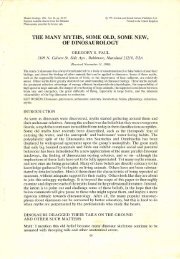HUNTERIA - Gregory S. Paul
HUNTERIA - Gregory S. Paul
HUNTERIA - Gregory S. Paul
You also want an ePaper? Increase the reach of your titles
YUMPU automatically turns print PDFs into web optimized ePapers that Google loves.
of the hand. Contrary to previous reports, the sauropod hand<br />
is not at all elephant-like - in fact it is unique and has only<br />
a thumb claw and no hooves. As restored the femur/tibia<br />
or fibula ratio of SITis a little higher than in other specimens<br />
(Table 1), but as the femur is always just a little shorter than<br />
the humerus in brachiosaurs, this ratio must be correct. The<br />
hindlimb is also columnar, and the foot is unguligrade and<br />
very elephant-like (excepting the three or four big laterally<br />
splayed banana claws; the outer one or two toes are neither<br />
clawed nor hooved). The astragular distal articulation faces<br />
more downwards and less forwards in well preserved sauropod<br />
ankles, relative to those of digitigrade prosauropods; therefore<br />
the sauropod foot is posturally unguligrade instead of plantigrade<br />
as suggested by Cooper (1984). The extremely short<br />
metatarsus and toes backed by a big pad show that the ankle<br />
was nearly immobile. The animal is shown in an elephantlike<br />
amble (Muybridge, 1887), its fastest gait.<br />
The most important point about the mounted HMN Sll<br />
is that the presacrals on display are not the originals, they<br />
are plaster models. The centra of the dorsal models are<br />
significantly larger than those of the originals, and Janensch's<br />
(1950b)paper skeletal restoration includes the s.ameerror. Why<br />
the modeled centra are so long is not clear, for although the<br />
dorsals are moderately crushed and too fragile to mount, most<br />
of the centra appear to be little altered in length. With centra<br />
of proper length, the dorsal column of B. brancai is some<br />
20% shorter relative to the limbs than indicated by ]anensch,<br />
even though one more vertebra is included in the new restoration.<br />
Other errors in Janensch's restoration include vertical<br />
anterior dorsal ribs and a shoulder girdle that is consequently<br />
too far forward - as well as too high - on the ribcage; scapula<br />
and humerus too short, a sprawling forelimb, and a tail that<br />
is too long, too heavy, and droops. Burian's well known<br />
restoration of the species emphasizes these errors, and also<br />
shows the neck much too short (Spinar and Burian, 1972)~<br />
In addition the claws are incorrect. Because the new restoration<br />
has a scaled up HMN Aa tail that is longer than it is<br />
in the mount and a dorsal column that is shorter, the<br />
differences cancel each other and the new restoration and the<br />
mount share nearly the same length of over 22 m.<br />
A very unusual feature ofB. brancai is the extreme height<br />
of dorsal vertebra 4, especially the neural spine, relative to<br />
both the cervicals and posterior dorsals. Unfortunately the<br />
immediately surrounding neural spines are not preserved, but<br />
it appears that this sauropod had "withers", tall neural spines<br />
over the shoulders (Figs. 1, 2B). Rebbachisaurus garasbae,<br />
a species possibly assignable to the Brachiosauridae, may have<br />
even taller withers (Lavocat, 1952).Withers are fairly common<br />
among mammals, but are unknown among other dinosaurs<br />
except for the chasmosaurian ceratopsids. This feature suggests<br />
that nuchal ligaments helped to support the neck. The withers'<br />
modest height and the long neck suggest the ligaments were<br />
rather low, like a camel's (Knight, 1947; Dimery et al., 1985).<br />
The ossified cervical "ligaments" cited by Migeod (1931) and<br />
Alexander (1985)are more probably displaced ends of the long<br />
cervical ribs (McIntosh, pers. comm.). Also unusual is the small<br />
size of the posterior dorsals, especially the centra. HMN Sll<br />
<strong>HUNTERIA</strong> VOL. IT, no. 3, pp. 4, February 19, 1988<br />
GREGORY S. PAUL<br />
and BMNH M 26 have posterior centra that are only 9 inches<br />
long! Although brachiosaur posterior dorsals are very different<br />
from the great posterior dorsals and sacrals of diplodocids, it<br />
does not follow that brachiosaurs were weak in the back.<br />
Obviously these giants did perfectly well with the posterior<br />
dorsals they had. Brachiosaur dorsals were not as specialized<br />
for rearing up as were diplodocid dorsals (Bakker, 1971C,1978).<br />
On the other hand brachiosaurs were like all other dinosaurs<br />
in being hindlimb dominant - the center of gravity was<br />
towards the rear so the hindlimb was more robust and supported<br />
more weight than the forelimb. This weight distribution<br />
made it easier for brachiosaurs to rear in search of choice<br />
-I









